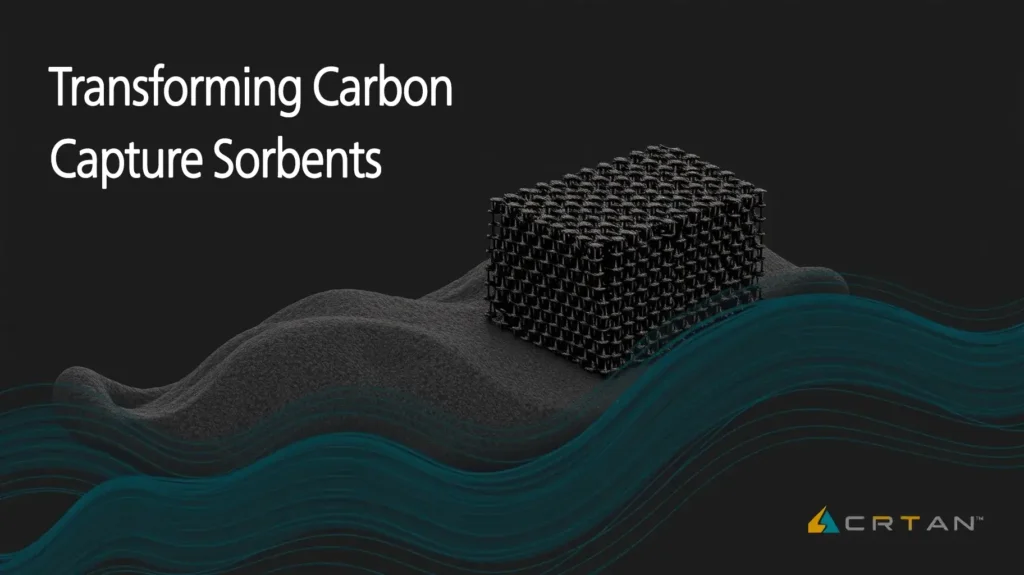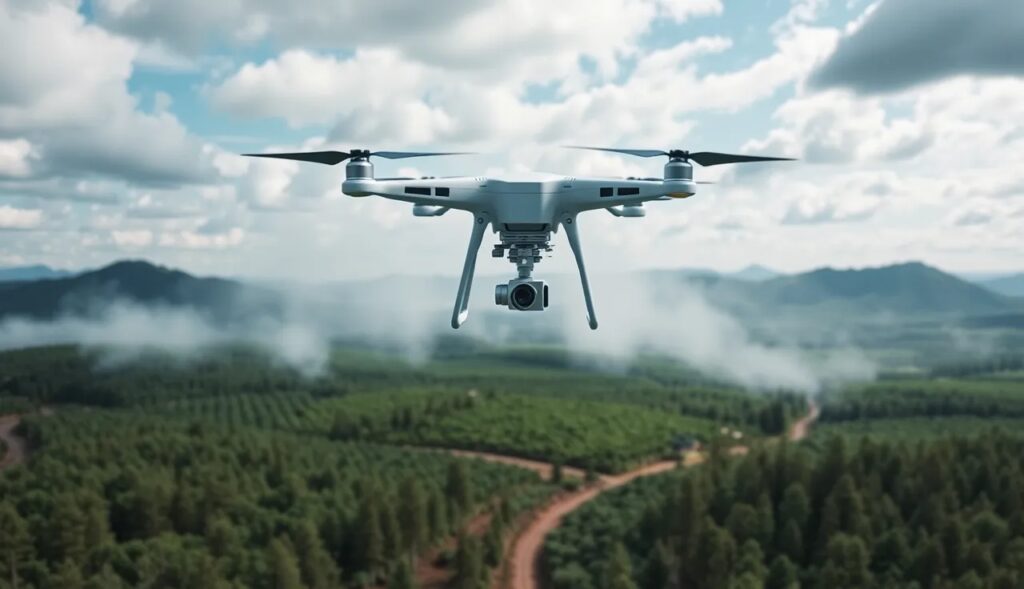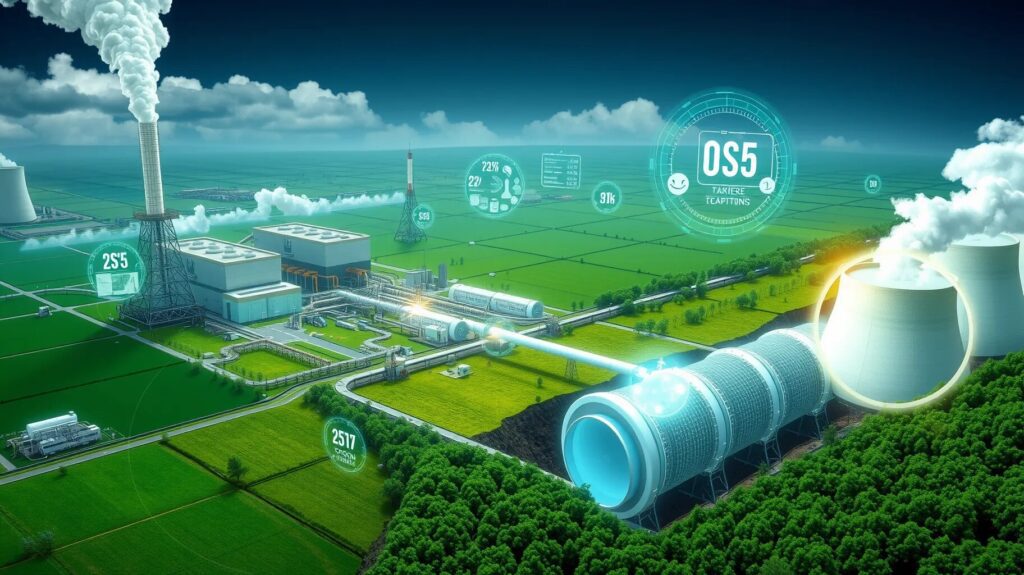
A New Era in Carbon Capture: How AI is Changing the Game
The fight against climate change is at a pivotal moment, and carbon capture technologies are emerging as essential tools to mitigate greenhouse gas emissions. But there’s one major hitch: developing the materials needed to trap carbon dioxide effectively has been a long, costly process. Fortunately, the rise of AI and machine learning is reshaping how we discover and optimize these critical materials, known as sorbents. With AI, what once took years of trial and error can now be accomplished in a fraction of the time, ushering in a new era of innovation for carbon capture.
Imagine this: algorithms capable of predicting the best materials for trapping CO2 before we’ve even made them in the lab! That’s the revolution AI is delivering.
What Are Sorbents? The Unsung Heroes of Carbon Sequestration
Sorbents are like the unsung heroes in the world of carbon sequestration. They are materials designed to capture carbon dioxide from the air or industrial emissions. Essentially, they “soak up” CO2, preventing it from escaping into the atmosphere, which is a crucial step in limiting the damage from industrial pollution. Some work by physically trapping CO2 molecules, while others undergo chemical reactions that bind the gas, making it easy to store or recycle.
Traditional sorbents like zeolites or metal-organic frameworks (MOFs) have been game changers, but they’re not perfect. For large-scale carbon capture and storage (CCS) systems, we need sorbents that are cheap, efficient, and stable under harsh conditions. This is where AI steps in with a much-needed boost.
Challenges in Sorbent Development: Why Traditional Methods Fall Short
For decades, material scientists have experimented with sorbents, trying to enhance their performance while keeping costs in check. Yet, the development process has been painstakingly slow. Each new material goes through rounds of testing, tweaking, and validation, often taking years before a viable candidate is ready for deployment. Plus, there’s a limit to how many combinations of chemicals and structures human researchers can test.
The limitations of traditional methods are evident—imagine searching for a needle in a haystack, but the haystack consists of millions of possible combinations! It’s a task too overwhelming for manual experimentation alone. As a result, many potential breakthroughs are left untapped simply because of the time and resources it would take to find them.
The marriage of AI and material discovery could be the breakthrough we need to make carbon capture viable.
— Jennifer Wilcox, Carbon Capture Scientist
AI and Machine Learning: The Perfect Partners for Material Discovery
Enter AI and machine learning. With AI-driven algorithms, material discovery moves from manual trial and error to predictive design. Rather than working with a limited pool of materials, AI can explore vast chemical and molecular spaces to identify potential sorbents that meet specific criteria for carbon capture. These systems can sift through millions of data points—something that would take human researchers centuries—and pinpoint optimal materials that might never have been considered otherwise.
Machine learning models, trained on past experiments, become increasingly adept at recognizing patterns. They know which molecular structures tend to succeed in trapping CO2 and which ones fail, allowing for faster and more accurate predictions.
Accelerating the Discovery Process: From Decades to Days
Traditionally, discovering a new material might take researchers years. First, they must come up with a hypothesis, synthesize the material, and then test it—over and over again until they get it right. With AI, this timeline has collapsed. Models can simulate a material’s properties and potential performance before it’s even created, narrowing down the field to only the most promising candidates.
Researchers are seeing stunning improvements in the speed of discovery. What once took decades of trial and error is now being done in days—or even hours. AI-driven platforms can even design completely new materials that were previously unimaginable to humans! This breakthrough isn’t just a time saver; it’s a game changer for carbon capture.
Customizing Sorbents: AI Designs with Precision and Purpose
One of the most exciting aspects of AI in material discovery is its ability to customize sorbents for specific needs. Different industrial processes emit carbon dioxide under varying conditions—temperature, pressure, and chemical environments—which means a one-size-fits-all solution won’t work. Traditional methods often led to compromises between performance and adaptability, but AI shifts that balance by tailoring sorbents down to the molecular level.
Using advanced algorithms, scientists can tweak the molecular composition of sorbents, making them more efficient for particular environments. For example, AI can design a sorbent that works best at high temperatures, perfect for industries like cement or steel production, or one that excels in capturing CO2 from the air, where concentrations are much lower. With these custom designs, the potential for higher efficiency and lower costs increases significantly.
Predictive Models: Anticipating Sorbent Performance Before Production
AI doesn’t just help in creating new sorbents—it can predict how well those materials will work before they are even synthesized. This is where predictive models come into play. These models, powered by machine learning and massive databases of past experimental results, can simulate a material’s properties and forecast how effective it will be at capturing CO2.
By feeding data from thousands of previous experiments into these models, AI learns which molecular structures tend to perform well under different conditions. It can assess things like absorption rates, stability, and the material’s ability to regenerate (release CO2 for reuse or storage), all without ever stepping foot in a lab. This reduces the guesswork and eliminates a huge amount of wasted time and resources.
The result? High-performing sorbents that are tested in virtual environments long before they ever need to be made in the real world. This technology is revolutionizing material discovery and cutting out much of the expensive trial-and-error phase that has traditionally slowed progress.
Environmental Impact: The Promise of AI-Enhanced Sorbents

With the ability to discover and optimize sorbents faster and more efficiently, AI is poised to have a tremendous impact on the environment. Sorbents designed with AI are likely to be more effective at capturing carbon dioxide and can be deployed on a much larger scale. This means that technologies like direct air capture (DAC) and point-source capture at industrial sites could become far more accessible and cost-effective.
But the benefits go beyond just capturing more CO2. The enhanced precision and customization that AI allows also mean we can design sorbents that use less energy during regeneration—the process of releasing the captured CO2 for storage. This makes the entire carbon capture and storage (CCS) cycle greener and more efficient, reducing the overall environmental footprint of these technologies.
In the long run, AI-optimized sorbents could be critical in helping countries meet their carbon neutrality goals. They offer the promise of a cleaner, more sustainable future, where capturing carbon emissions becomes not just feasible, but commonplace.
Economic Viability: AI’s Role in Reducing Costs for Carbon Capture
While environmental impact is crucial, so is economic viability. For carbon capture to make a real dent in global emissions, it has to be affordable enough for widespread adoption. The current high cost of CCS technologies has been a barrier, but AI may change that. By streamlining the material discovery process, AI reduces the costs associated with developing high-performance sorbents.
AI-driven discovery also helps lower costs by producing sorbents that last longer and require less maintenance, reducing operational expenses. Additionally, AI can optimize sorbents to work in specific environments, leading to higher efficiency and less energy consumption—which directly translates to lower energy bills.
As AI continues to improve and scale up the discovery process, we can expect to see carbon capture costs drop, making it a more attractive solution for industries and governments alike. This could spark a wave of investment in carbon capture technologies, further driving down costs through economies of scale.
Case Studies: AI Success Stories in Sorbent Innovation
There are already some impressive examples of AI’s success in this space. Take the case of a collaboration between ExxonMobil and the National Renewable Energy Laboratory (NREL), where AI was used to identify new metal-organic frameworks (MOFs) for carbon capture. In a matter of weeks, AI models evaluated thousands of potential MOF structures, narrowing the field to just a handful of high-performing candidates.
Another striking example is from UC Berkeley, where researchers used machine learning to accelerate the discovery of a MOF that can capture carbon dioxide with unmatched efficiency. The AI model was able to predict the best materials with over 90% accuracy, dramatically speeding up the development process.
These case studies highlight how AI is already making a tangible impact in the field of sorbent development, delivering breakthroughs that would have been unthinkable just a decade ago. As more institutions and industries turn to AI, the pace of innovation is only expected to accelerate.
Overcoming Hurdles: Ethical Considerations and AI Limitations
Despite the incredible potential of AI in material discovery, there are some ethical concerns and limitations that need to be addressed. As with many AI applications, there is a risk of over-reliance on algorithms that may not fully consider the broader environmental or societal impacts of their recommendations. For instance, an AI might suggest materials that are effective in capturing CO2, but their production might involve mining rare earth elements, leading to other forms of environmental degradation.
There’s also the data privacy issue. When companies and research institutions develop AI-driven technologies, they must share vast amounts of experimental and proprietary data, which raises concerns over ownership and the ethical use of data. Furthermore, the development of AI tools is often concentrated within a few powerful corporations or well-funded research institutions, leading to disparities in access to this technology. This can deepen the divide between developed and developing nations, exacerbating global inequality when it comes to adopting carbon capture technologies.
Finally, AI itself isn’t perfect. Algorithms can sometimes overlook unpredictable variables in real-world environments that weren’t accounted for in their data sets, leading to potential errors in predictions. Therefore, human oversight is still crucial, ensuring that AI’s insights are applied judiciously.
The Road Ahead: AI, Sorbents, and the Future of Carbon Capture
As AI continues to evolve, its role in carbon capture is only set to expand. The future looks promising, with AI helping to push the boundaries of sorbent design and optimization, making the capture of CO2 more efficient, cost-effective, and environmentally friendly. With advances in quantum computing, AI’s computational power could soar, allowing it to solve even more complex material discovery problems that are currently out of reach.
Moreover, as governments and industries worldwide ramp up their climate goals, we will likely see increased investments in AI for carbon capture technologies. Collaboration between AI researchers, material scientists, and environmental policymakers could lead to a global surge in innovation, addressing the pressing need to reduce emissions at a larger scale.
Beyond that, AI could even aid in the deployment of carbon capture systems, optimizing their placement and operations for maximum impact. The goal is to make carbon capture and storage (CCS) systems a widespread reality, integrated into industries across the globe, and driven by AI-enhanced sorbents.
Beyond Sorbents: Other AI Applications in Sustainability
While AI’s impact on sorbent discovery is remarkable, its applications extend far beyond that. In the broader context of sustainability, AI is being used to improve energy efficiency, develop renewable energy technologies, and optimize supply chains to reduce waste. For example, AI algorithms can optimize wind farm layouts for maximum energy output, or help identify high-potential sites for new solar farms.
In agriculture, AI-powered sensors and predictive models are being used to monitor soil health, water usage, and crop performance, making farming more sustainable and resource-efficient. AI-driven climate models are also becoming indispensable tools for predicting extreme weather events, enabling better preparedness and mitigation efforts.
Essentially, AI has become a powerful tool for tackling a wide array of environmental challenges, making it a key player in the pursuit of a more sustainable planet.
Global Collaboration: How AI is Uniting Scientists for a Greener Planet
One of the most promising aspects of AI’s role in carbon capture is its potential to foster global collaboration. Unlike traditional research methods, where breakthroughs can take years and are often siloed within individual institutions, AI enables scientists from all over the world to share data, models, and findings in real time. This accelerates progress and opens the door for cross-disciplinary and international partnerships.
For example, open-source AI platforms are allowing researchers to contribute and access vast databases of material properties, which helps to streamline and democratize the discovery process. Additionally, cloud-based AI tools enable researchers in developing countries to access cutting-edge technology without needing their own expensive infrastructure.
As more nations pledge to reach net-zero emissions, AI could become a unifying force, helping countries work together to achieve these global climate goals. By combining the power of AI with human ingenuity, the world can make significant strides toward a more sustainable future.
Public Perception: Addressing Fears and Misconceptions Around AI
Despite its benefits, AI is not without its detractors. There are lingering fears about automation displacing jobs, as well as concerns over transparency and bias in AI algorithms. When it comes to environmental applications, there’s also skepticism around the idea of relying on AI to solve problems as complex and critical as climate change.
To build public trust, it’s essential to maintain transparency in how AI-driven solutions are developed and deployed. This includes ensuring that the technology is subject to rigorous ethical standards, and that human oversight is never entirely eliminated. Additionally, clear communication is key—people need to understand how AI contributes to carbon capture and why it’s an indispensable tool in the fight against climate change.
Engaging the public through education, highlighting success stories, and dispelling misconceptions will be crucial in gaining widespread support for AI-powered sustainability initiatives.
A Sustainable Future: Can AI Solve the Climate Crisis?
AI isn’t a silver bullet, but it’s certainly a game-changing tool in the fight against climate change. While AI alone can’t solve the climate crisis, it provides a critical advantage by accelerating innovations like carbon capture, renewable energy, and sustainable resource management. By streamlining material discovery, as seen with AI-enhanced sorbents, we can develop solutions faster and more efficiently than ever before.
Yet, to truly make an impact, AI must be used in conjunction with a variety of other strategies—like policy reforms, shifts in public behavior, and industrial changes. The power of AI lies in its ability to help us optimize, predict, and innovate across multiple sectors, giving humanity the tools it needs to combat the climate crisis.
One of the most promising aspects of AI-driven carbon capture technologies is their potential scalability. As these systems become more cost-effective and efficient, they can be deployed in heavily polluting industries, urban centers, and even in direct air capture systems. These technologies could one day help balance out the carbon budget by capturing the emissions we’re unable to eliminate through other means.
Collaborating for a Carbon-Neutral World
For AI to truly revolutionize carbon capture and material discovery, collaboration will be key. Scientists, technologists, policymakers, and industries must work together, sharing data, research, and strategies. This kind of global teamwork is essential to creating sustainable solutions that are accessible to all nations, not just the wealthiest or most technologically advanced.
AI also makes cross-border collaboration easier, allowing nations to share advancements in real-time, speeding up the pace of innovation. By fostering these kinds of partnerships, we can more effectively scale AI-driven carbon capture solutions to meet global climate targets.
AI: A Crucial Piece of the Puzzle
Ultimately, AI is one piece of a larger puzzle in addressing the climate crisis. It can revolutionize carbon capture, improve sorbent design, and help reduce the costs associated with green technologies. But it must be integrated into a broader, multi-faceted approach to climate change—one that includes policy action, global collaboration, and shifts in industrial practices. The good news is that AI, when used wisely, can help us find the pieces we’ve been missing.
By harnessing the power of machine learning and advanced data analytics, we can supercharge the pace of discovery and unlock solutions that were previously out of reach. While challenges remain, the future looks brighter with AI as an ally in the battle for a carbon-neutral world.
AI is more than just an assistant—it’s a revolutionary force that could help lead us toward a greener, more sustainable future. If we continue to push the boundaries of what’s possible, while ensuring ethical and equitable development, AI could become one of the most valuable tools we have in the fight against climate change.
Resources
- MIT Technology Review – “How AI is Supercharging Carbon Capture Technology”
MIT Technology Review often covers breakthroughs in AI and carbon capture. This article explores how AI is accelerating the development of sorbents and other carbon capture technologies. - National Renewable Energy Laboratory (NREL) – AI-Driven Materials Discovery for Carbon Capture
NREL provides insights into AI applications in renewable energy and carbon capture materials research, including case studies from their collaborations with industry. - The International Energy Agency (IEA) – Carbon Capture, Utilisation, and Storage
The IEA’s CCUS section offers comprehensive data and reports on the state of carbon capture technologies and the role AI plays in driving innovation. - Nature Communications – “AI-Driven Discovery of New Carbon Capture Sorbents”
Nature Communications publishes peer-reviewed studies on cutting-edge technologies, including AI’s role in material science for climate solutions. - ExxonMobil and Berkeley Lab – “AI in Carbon Capture Material Discovery”
Case studies of AI-driven advancements in carbon capture, highlighting collaborations between academia and industry. Information can be found on ExxonMobil’s sustainability site or Berkeley Lab’s research page. - “Artificial Intelligence for Accelerating Discovery of Materials for Carbon Capture” – American Chemical Society (ACS)
The ACS publications site provides technical papers and research studies on how AI is revolutionizing carbon capture material discovery. - Global CCS Institute – “The Role of AI in Scaling Carbon Capture”
This organization offers reports on the challenges and opportunities in scaling carbon capture technologies, including how AI is being used to overcome obstacles. - Journal of Cleaner Production – AI-Enhanced Sorbents for CO2 Capture
This academic journal publishes research on sustainable technologies, with articles focused on how AI can optimize sorbents for more efficient CO2 capture.





